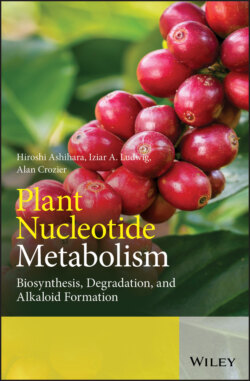Читать книгу Plant Nucleotide Metabolism - Hiroshi Ashihara - Страница 41
3.4.1 ATP Synthesis by Electron Transfer Systems
ОглавлениеThe conversion of ADP to ATP is performed by phosphorylation linked to the electron transport chains of respiration and photosynthesis (Karp 2013; Niyogi et al. 2015). Briefly, in oxidative phosphorylation, electrons are derived from substrates that enter the TCA (tricarboxylic acid) cycle (aka the citrate or Krebs cycle) (Figure 3.2), whereas in photophosphorylation, they are furnished by chlorophyll in the presence of light. ATP synthesis is coupled to the subsequent successive oxidation–reduction of members of electron transport chains, which pass electron pairs through stages of successively lower potential energy until they reach oxygen, the terminal electron sink. ATP synthase (H+-transporting two-sector ATPase, EC 3.6.3.14) is an enzyme that creates ATP. It is formed from ADP and Pi (Table 3.1).
Figure 3.2 The tricarboxylic acid (Krebs) cycle in plants. (1) Pyruvate dehydrogenase; (2) citrate synthase; (3) aconitase; (4) isocitrate dehydrogenase; (5) 2-oxoglutarate dehydrogenase; (6) succinyl-CoA synthetase; (7) succinate dehydrogenase; (8) fumarase; (9) malate dehydrogenase.
